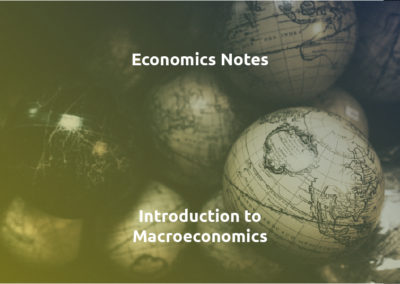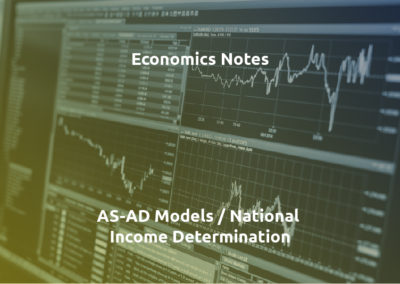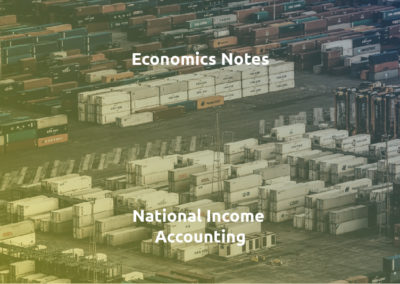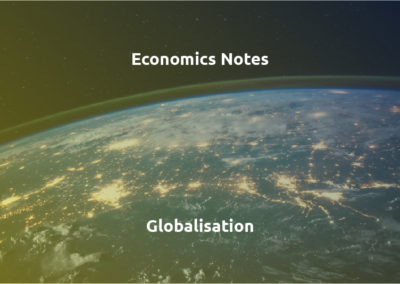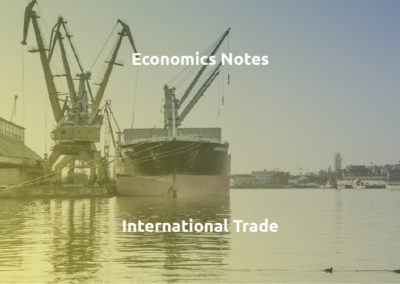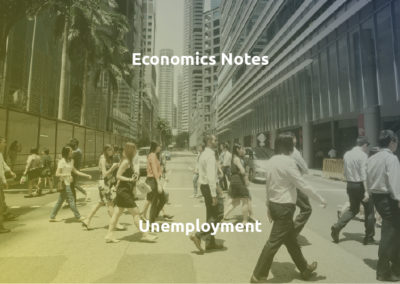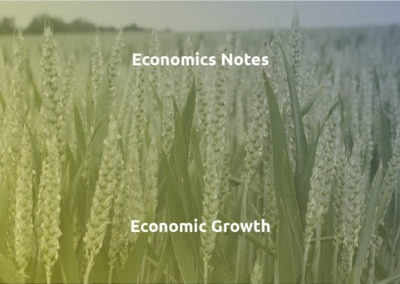JC Economics Tuition Notes
Introduction to Macroeconomics
Introduction to Macroeconomics
Definition of Macroeconomics
Macroeconomics refers to the study of the economic activities that are conducted within an economic entity and the economic activities that the economic entity conducts with other countries. (International Trade and foreign direct investment)
As stated by John Sloman, Macroeconomics is the branch of economics that studies economic aggregates (grand totals) : eg. The overall level of prices and, output and employment in the economy.
[read more=”+ Read More” less=”– Read less”]In this process, it involves the studies of economic activities that will affect the development of an economy which will affect how the economy attains the primary aims of the economy such as economic growth, price stability, employment and external equilibrium (four Main aims of the government) – economic performance analysis
The studies of the macroeconomics are based on national aggregates which only include the total values of all economic activities and disregard the values of the economic activities of the individuals.
While the concerns of the microeconomics cover the profit maximization of firms and the welfare maximization of the individuals and the society, the concerns of macroeconomic studies are different.
[/read]
Areas of Discussion
- Short and long term economic growth
- Price stability
- Low unemployment
- External equilibrium (Balance of Payment Equilibrium)
Macroeconomic aims of the government
- Higher standard of living
- Equal Distribution of income and wealth (inclusive growth)
- Healthy balance of Trade Equilibrium
- Exchange Rate stability
- High degree of competitiveness
- Healthy flow of investment (Foreign / Local)
Importance of Macroeconomics
Why study Macroeconomics?
Principles of Economics are founded on the basis of social science where they can be used to explain how the various economic entities will conduct their economic activities. They are used to explain how the economic entities will attain their maximization and reach the equilibrium level for a particular market or the economy. The notion of maximization for the individuals, the firms, the society and the countries will guide economic activities to attain an equilibrium level of consumption and production that satisfy the interests of all economic entities at different markets and economic system.
Macroeconomics activities
Main aims of an economy
The understanding of the flow of economic activities will enable the economy to ensure that the economic policies conducted will achieve the various aims of the economy which is of great imperative to the economy. The aims and concerns of the economy may be the main and subsidiary focus.
Sustained economic growth
Economic growth refers to expansion of the resource and production of the economy. Expansion of the production capacity of the economy refers to the growth in the GDP or GNP or the shift of production level from one combination level of production to another level of productions within the PPC (production possibility curve) – Actual growth
Expansion of the resource capacity of the economy refers to the outward shift of the full employment level of production or the outward shift of the PPC from PCC1 to PCC2. – Potential Growth
Sustained economic growth refers to the expansion of production without experiencing rising price level as a result of inadequate supply of resources. It is important for the government seek to attain sustainable growth as this will ensure that there is perpetual economic growth and the assurance that there is minimum economic wastage
Low Inflation rate
Inflation refers to the sustained and inordinate change in price level which is measured by the rate of change in consumer Price Index (CPI)
Low inflation will enable the economy to maintain price and cost condition so as to maintain a low cost of production to raise competitive edge and cost of living to sustain economic growth and maintain high standard of living.
low price – less demand for wage increment – keep COP – keep price of good and services low
Low unemployment rate
Unemployment of labor refers to condition where people who are available for work and are actively seeking work cannot find jobs (active working population or labour force)
Low unemployment condition is important as it ensures the full utilization of resources in the economy (prevent waste of human resources).
Low unemployment will help to prevent the rise of social problems that affect the stability of an economy
Low unemployment will also help the government to reduce government expenditure spent on unemployment benefit.
External equilibrium (balance of payment equilibrium)
External stability of the economy refers to the stability of balance of payment which shows the record of a country’s international transactions, involving trading activities of services and products, flows of investment and fund and sources of reserves and funds available in the economy. (Main components of BOP are current account, capital account and financial account)
External stability or BOP equilibrium is critical to an economy as it will affect the financial reserves of the country and the exchange rate stability: An unstable exchange rate will create adverse effect on international trade and economic growth.
Balance of Payment deficit – inflow of money is less than the outflow of money – fall in demand for the Sing $ / increase in supply of Sing $ – depreciation of Sing $.
Macroeconomics activities
Other macroeconomic aims
Besides the main macroeconomic aims of the economy, the economy has other areas of concern that are of great importance as these concerns affect the performance of the economy.
Higher standard of living
Standard of living refers to the measurement of the level of well-being of the individuals of an economy will enjoy and it can be measured on a qualitative or quantitative level.
Standard of living is important to an economy as it depicts whether the individuals are having a considerable level of living with the given production capacity of the economy.
Standard of living is also a social and political measurement of the country’s governance in the management of the economy for the improvement of the well-being of the citizens.
Equal distribution of income and wealth (inclusive growth)
Attaining equal distribution of income and wealth implies that there is minimum disparity of wage and income differences and concentration of wealth within a small fraction of the population.
The aim to attain equal distribution of income and wealth is a concern of the economy as it will affect the wellbeing of the individuals. The well-being of the individuals is of concern to the economy as the poor state of well-being of the individuals creates discontent and dissatisfaction that will undermine the social stability of the society and thus, disrupt the efficient conduct of economic activities.
The minimization of unequal distribution of income and wealth will reflect the effective governance of the economy by the government as it reflects the degree of care the state will provide for the mass population.
Healthy balance of trade (current account balance)
Balance of trade (Net trade –X -M) records the overall net transactions of the imports and exports of physical goods of a country with other countries
Healthy balance of trade is important to an economy as it will determine production capacity which influences the level of employment, national income and standard of living.
SG export demand is 3 times the value of GDP – high degree of dependency on trade
For small economy, the trading activities reflected by the balance of trade will indirectly determine foreign direct investment and the standard of living.
Exchange rate stability
Exchange Rate stability refers to the absence of extensive rise or fall in the value of a country’s currency measured in terms of another country’s currency.
Excessive fluctuation in exchange rate will affect trading prices and cost of foreign direct investment which will create extensive impact on the resource and production capacity. (Gradual and modest appreciation)
Exchange rate instability will affect the price stability of good and services and this will affect the trading activities as there is lesser transaction due to uncertainty in price level.
High degree of competitiveness (cost, price and quality of goods)
High degree of competitiveness refers to the condition of low cost of production which will help to lower cost of Foreign Direct Investment and export prices to attract more FDI and raise export revenue.
It can also be seen in term of the improvement of the quality of products through technological and product innovation.
With higher export demand and Foreign Direct Investment, the economy can attain higher level of employment and economic growth.
It is important for Singapore to maintain high degree of competitiveness as it relies extensively on the external market for economic growth. The lack of a sizeable local market implies that it needs to raise its market demand through export which will determine the level of production, employment and economic growth
Regional competition from countries like China and Vietnam are making it difficult for Singapore to attract more FDI as these countries offer lower cost of labour and have cheap abundant resources. It is important for Singapore to move up the production ladder with high-valued production and product innovation.
Healthy flow of (foreign/local) investment
Appropriate level of investment is critical in ensuring the production capacity can be increased at sustainable level.
It can also determine the level of employment which will ensure that individuals can attain a source of income to maintain and improve their standard of living.
Flow of investment can either be from local and foreign source.
Circular flow of income
The circular flow of income will account for the flow of economic activities within the economy and the economic activities with other economies. Within the circular flow of income, the economic activities accounted are seen in four sectors, implying an open economy with government intervention.

The circular flow of income will also indicate how the value of national income can be attained based on the withdrawal and injection approach or the general equilibrium model, derived from the income, expenditure and output approach of calculation of the national income.

The value of national income can be derived when the economy attained equilibrium when total aggregate demand of the economy is equal to the aggregate income or when the sum of the withdrawals is equal to the sum of injections. In this circular flow of income, the various forms of economic activities are identified by the different flows through the different economic sectors which will provide an understanding on how economic activities are affecting the economy. (NY = AD = C+I+G+(X-M))

Based on the general equilibrium model, the level of output or real GDP in the short run can be derived and is at the level where the real GDP is at Yo and the general price level is set at Po when the aggregate demand AD is equal to the aggregate supply AS (seen from the point of intersection).
At this level of output, it will indicate the level of real national income or the total actual level of output produced by the economy and thus indicating the level of employment. The understanding of how economic activities will affect the economy will be seen by how they affect the sum of aggregate demand and supply which is explained differently by different school of thoughts. (Classical., Monetarist, Keynesian)
At Eo, the economy is at full employment when it attained equilibrium where the AD = AS when the GPL and the real output is at Yo and Yo is equal to Yf.
At E1, the economy is experiencing inflation when attained equilibrium where AD = AS when the GPL is at P1 and real output (real GDP) is at Y1 = Yf.
At E2, the economy is experiencing recession when attained equilibrium where AD = AS when the GPL is at P2 and real output (real GDP) is at Y2 which is lower than Yf.
Economics Tuition Discussion
Do share with us your question regarding this chapter.
More Macroeconomics Notes
Read the other chapters on Macroeconomics

